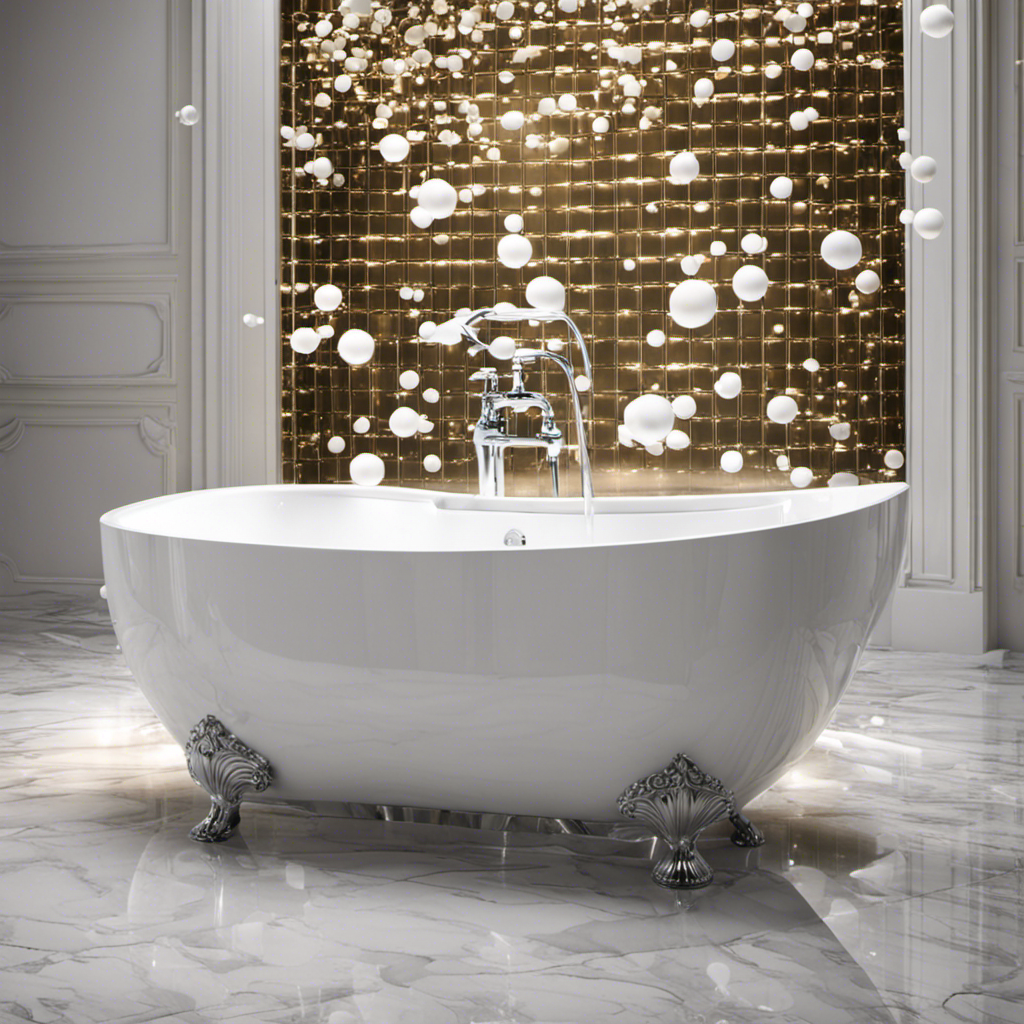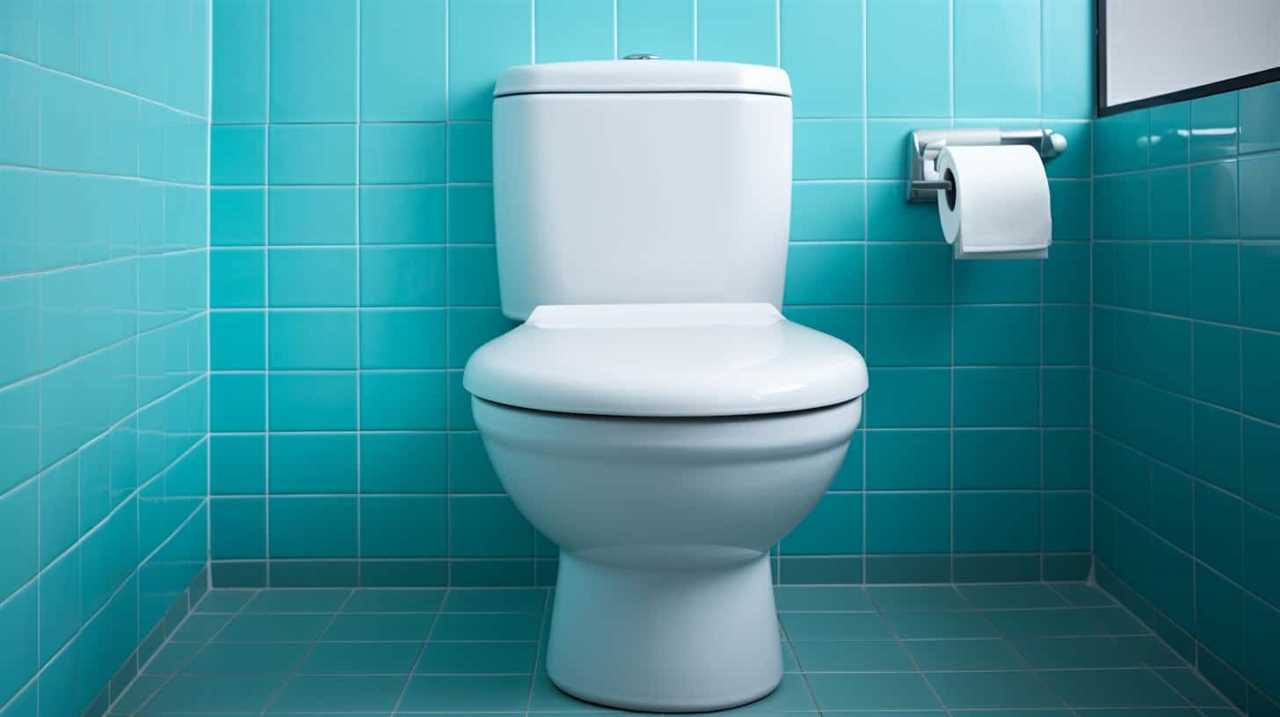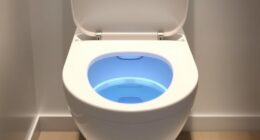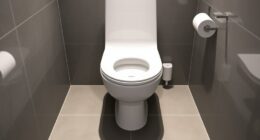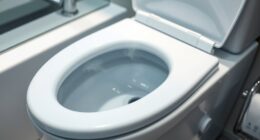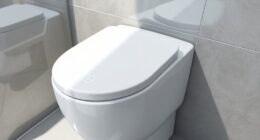So, you’re taking a nice, relaxing soak in your bathtub, surrounded by bubbles and bliss. But have you ever stopped to wonder what your trusty tub is actually made of? Well, fear not, because I’m here to uncover the mystery for you.
In this technical and informative article, I’ll delve into the various options available, from fiberglass and acrylic to porcelain-enameled steel and cast iron. Get ready to have your mind bathed in knowledge as we explore the materials that make up your beloved bathtub.
Key Takeaways
- Acrylic and fiberglass are lightweight and durable options for bathtubs.
- Porcelain and porcelain-enameled steel provide a classic and elegant look but require careful maintenance to avoid chipping or staining.
- Cast iron requires regular maintenance to prevent rust but offers a durable and classic aesthetic.
- Wood bathtubs offer a unique and natural aesthetic, are highly durable, and require regular sealing and mild soap for cleaning.
Material Options
There are several material options for bathtubs, such as acrylic, fiberglass, and porcelain. Each material has its own pros and cons, and it’s important to choose the right one for your bathtub based on your needs and preferences.
Acrylic bathtubs are lightweight, durable, and easy to clean, making them a popular choice among homeowners. However, they can be prone to scratching and may fade over time.
Fiberglass bathtubs are affordable and easy to install, but they are less durable and can crack or chip.
Porcelain bathtubs are known for their classic, elegant look, but they are heavy and require careful maintenance to avoid chipping or staining.
When choosing a material for your bathtub, consider factors such as durability, maintenance, cost, and aesthetics. With an understanding of the pros and cons of different materials, you can make an informed decision for your bathroom renovation.
Now, let’s explore the specifics of fiberglass bathtubs.
Fiberglass Bathtubs
Fiberglass bathtubs are commonly used in modern bathroom designs. They are a popular choice due to their many benefits. Firstly, fiberglass is a lightweight material, making installation easier and cost-effective. Secondly, fiberglass is highly durable and resistant to scratches and cracks, ensuring longevity. The material also retains heat well, providing a comfortable bathing experience.
To properly maintain a fiberglass bathtub, it is important to follow some tips. Firstly, avoid using abrasive cleaners or scrub brushes that can damage the surface. Instead, use gentle, non-abrasive cleaners and a soft cloth or sponge. Regularly cleaning the bathtub will help prevent the build-up of grime and soap scum. Additionally, avoid using harsh chemicals, as they can dull the finish of the fiberglass. Finally, it is recommended to periodically apply a coat of wax or polish to protect the bathtub’s surface and keep it looking new.
| BENEFITS OF FIBERGLASS BATHTUBS | MAINTENANCE TIPS FOR FIBERGLASS BATHTUBS |
|---|---|
| Lightweight | Avoid abrasive cleaners |
| Durable | Regular cleaning |
| Retains heat well | Avoid harsh chemicals |
| Cost-effective installation | Apply wax or polish periodically |
Acrylic Bathtubs
Acrylic bathtubs offer a sleek and modern design that is popular among homeowners. Compared to fiberglass bathtubs, acrylic tubs have several distinct advantages.
Firstly, acrylic is a highly durable material that is resistant to scratches and stains, making it ideal for long-term use.
Additionally, acrylic retains heat better than fiberglass, providing a more comfortable soaking experience. It also has excellent color retention, ensuring that the bathtub maintains its vibrant appearance over time.
Another benefit of acrylic bathtubs is their versatility in terms of shape and size, allowing for customization to fit any bathroom layout.
Furthermore, acrylic is non-porous, making it resistant to mold and mildew growth.
In summary, acrylic bathtubs offer durability, heat retention, color retention, versatility, and resistance to mold, making them a popular choice among homeowners.
Moving on to porcelain-enameled steel bathtubs…
Porcelain-Enameled Steel Bathtubs
If you’re looking for a more affordable option, porcelain-enameled steel bathtubs might be a great choice for you. These bathtubs are made from a steel base that is coated with a layer of porcelain enamel.
One of the main advantages of porcelain-enameled steel bathtubs is their affordability. They are generally less expensive compared to other types of bathtubs, making them a budget-friendly option.
Additionally, these bathtubs are durable and resistant to chipping and scratching, thanks to the porcelain enamel coating. However, there are also some disadvantages to consider.
Porcelain-enameled steel bathtubs are prone to rusting if the enamel coating gets damaged. They can also be noisy when water hits the steel surface.
Despite these drawbacks, porcelain-enameled steel bathtubs are a popular choice for those looking for an affordable and durable bathtub option.
Moving on to cast iron bathtubs…
Cast Iron Bathtubs
Moving on to cast iron bathtubs, they are known for their durability and classic aesthetic. Cast iron is a popular choice for bathtubs due to its strength and longevity. One of the benefits of cast iron bathtubs is their ability to retain heat, providing a luxurious and relaxing bathing experience. Additionally, their solid construction helps reduce noise and vibrations, creating a serene atmosphere in your bathroom.
To care for a cast iron bathtub, it is important to avoid using abrasive cleaners or scrub brushes that can damage the enamel finish. Instead, use a mild soap or non-abrasive cleaner and a soft cloth to clean the surface. Regular maintenance, such as wiping away water droplets after use, will help prevent rust and keep your cast iron bathtub looking its best.
Transitioning into the subsequent section about solid surface bathtubs, let’s explore another popular bathtub material option.
Solid Surface Bathtubs
Now that we’ve discussed cast iron bathtubs, let’s move on to another popular option: solid surface bathtubs. Solid surface bathtubs are made from a composite material that is both durable and versatile. One of the primary benefits of solid surface bathtubs is their ability to mimic the look of natural stone or marble, giving your bathroom an elegant and luxurious feel. Additionally, solid surface bathtubs are non-porous, meaning they are resistant to stains and bacteria growth. This makes them easy to clean and maintain. To keep your solid surface bathtub looking its best, it is recommended to use non-abrasive cleaners and avoid harsh chemicals. Regular wiping and drying after each use will help prevent the build-up of soap scum and water spots. Overall, solid surface bathtubs offer both aesthetic appeal and practicality, making them a great choice for any bathroom.
| Benefits of Solid Surface Bathtubs | Maintenance Tips for Solid Surface Bathtubs |
|---|---|
| Mimics the look of natural stone or marble | Use non-abrasive cleaners |
| Durable and long-lasting | Avoid harsh chemicals |
| Non-porous and resistant to stains and bacteria growth | Regular wiping and drying after each use |
Wood Bathtubs
Wood bathtubs offer a unique and natural aesthetic to any bathroom space. Made from high-quality wood, these bathtubs provide numerous advantages.
Firstly, wood bathtubs are highly durable and long-lasting, thanks to the strength and resilience of the material. They are also excellent at retaining heat, providing a warm and cozy bathing experience.
Additionally, the natural textures and grains of the wood create a visually stunning and soothing environment.
In terms of maintenance, wood bathtubs require regular sealing to protect against water damage and to maintain their appearance. It is important to clean them with mild soap and avoid using abrasive cleaners that may damage the wood.
With proper care, a wood bathtub can be a beautiful and functional addition to any bathroom.
Conclusion
In conclusion, determining the material of your bathtub is crucial for maintenance and durability. Fiberglass and acrylic bathtubs offer lightweight and easy-to-clean options, while porcelain-enameled steel and cast iron bathtubs provide sturdiness and a classic look.
Solid surface bathtubs offer a seamless and customizable design, while wood bathtubs provide a unique and natural aesthetic. So, next time you soak in your tub, take a moment to appreciate the material it’s made of, and ask yourself, "Doesn’t knowing the composition of my bathtub make the bathing experience even more delightful?"
After all, knowing the thought and craftsmanship that went into creating such a beautiful and functional piece only adds to the joy and relaxation of my bathing experience.

